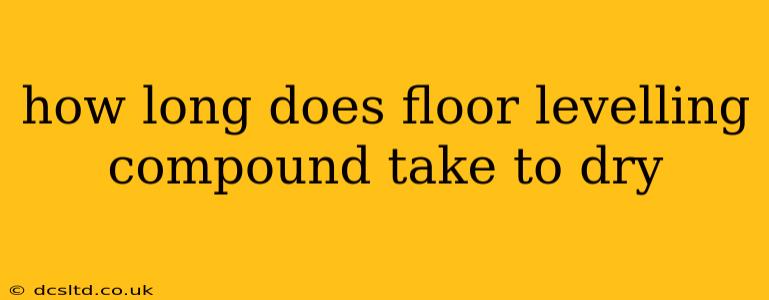Leveling your floor can dramatically improve the look and feel of a room, creating a smooth, even surface perfect for flooring installation. But before you start laying down new tiles or carpeting, you need to understand how long your chosen floor leveling compound will take to dry. This isn't a one-size-fits-all answer, as drying time depends on several crucial factors. Let's delve into the details.
What Factors Affect Floor Levelling Compound Drying Time?
Several factors influence how long your floor levelling compound needs to dry completely:
-
Type of Compound: Different compounds have different drying times. Self-levelling compounds, for instance, often dry faster than traditional compounds requiring manual spreading. Check the manufacturer's instructions—this is paramount! The specific product will have a stated drying time under ideal conditions.
-
Thickness of the Application: Thicker layers take considerably longer to dry than thinner ones. A thin skim coat might dry within a few hours, while a thicker application could require a full day or even longer. Always follow the manufacturer's recommended application thickness.
-
Room Temperature and Humidity: Warmer temperatures and lower humidity accelerate drying. Conversely, cooler temperatures and high humidity will significantly prolong the drying time. Ideally, aim for a well-ventilated room with a consistent temperature.
-
Ventilation: Good air circulation helps to speed up the drying process. Open windows and doors to allow for proper ventilation. Avoid drafts which could cause uneven drying and cracking.
-
Substrate: The type of surface you're applying the compound to can impact drying time. A porous substrate like concrete might absorb some of the moisture, potentially affecting the drying time.
How Long is "Dry Enough" for the Next Steps?
This is where things get a bit nuanced. Simply waiting until the surface appears dry isn't sufficient. You need to consider:
-
Surface Dry: The surface might feel dry to the touch after a few hours, but the compound may still contain moisture deeper within. This isn't suitable for most flooring installations.
-
Walkable: Many manufacturers indicate a "walkable" time, which is when you can carefully walk on the surface without leaving footprints. This is usually longer than the surface-dry time.
-
Ready for Flooring: This is the most crucial point. This is the time frame specified by the manufacturer when the compound is fully cured and suitable for the installation of your chosen flooring. This often involves a longer waiting period than simply being walkable. Premature flooring installation can lead to problems such as delamination or bubbling.
How Long Does it Typically Take?
While specific drying times vary widely, here's a general guideline:
-
Thin skim coats: May dry to the touch in a few hours, but full cure could take 12-24 hours.
-
Medium thickness: Could take 1-2 days for a walkable surface and 2-3 days for full cure.
-
Thick applications: Might require 3-5 days or even longer for complete curing.
What Happens if it Takes Longer Than Expected?
Several reasons might cause your floor leveling compound to dry more slowly than anticipated:
-
High humidity: Consider using dehumidifiers to reduce moisture in the air.
-
Low temperature: Increase room temperature if possible.
-
Poor ventilation: Ensure sufficient airflow by opening windows and doors (weather permitting).
What are the consequences of rushing the drying process?
Rushing the drying process by using heaters or inadequate ventilation can lead to several problems:
-
Cracking: Uneven drying can cause cracking in the compound.
-
Bubbling: Trapped moisture can lead to bubbling under the flooring.
-
Delamination: The flooring may separate from the compound.
Always consult the manufacturer's instructions for your specific floor leveling compound. This will provide the most accurate drying times and crucial installation guidelines. It's better to err on the side of caution and allow ample drying time to prevent costly mistakes.
